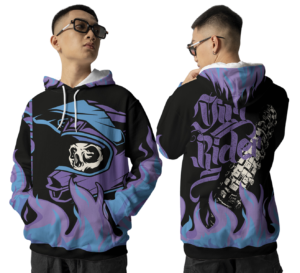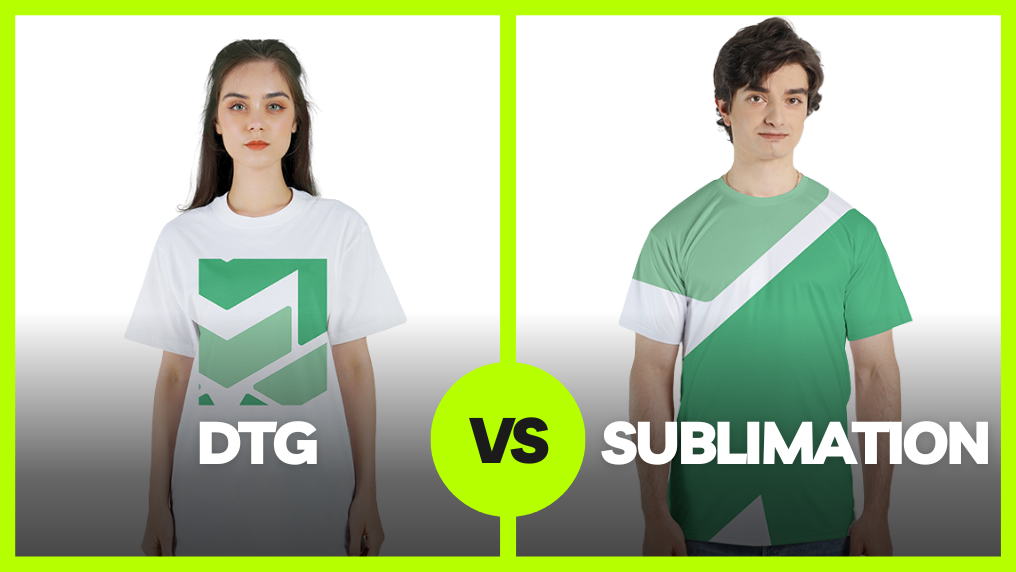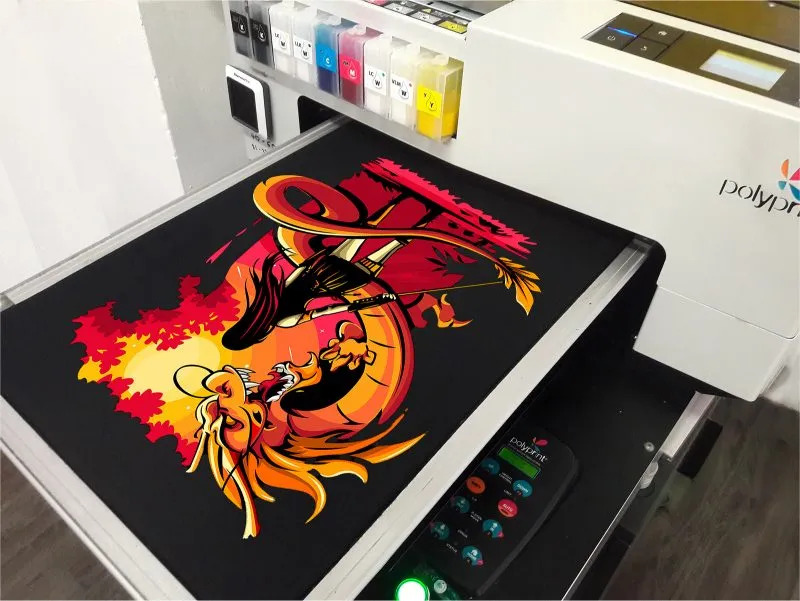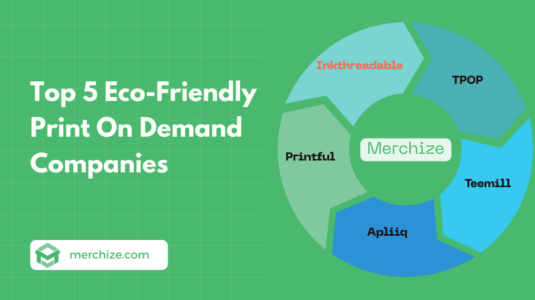Contents
Direct-to-garment vs Sublimation? This question might have baffled a lot of POD sellers before. Let’s read and dive into these printing techniques to get yourself the answer.
Besides mastering the art of marketing and design, it is also important for print-on-demand business owners to have some understanding of the printing process to make informed decisions on what products to sell and how to market their products correctly to customers.
Sublimation vs direct-to-garment are two popular printing techniques that are usually applied to make print-on-demand products. If you are still confused about how these printing techniques are different from each other and what are the best options for your print-on-demand providers, the following article will help you understand the pros and cons of each print technique.
Direct-to-garment vs Sublimation printing: The definition
What is Direct-to-garment printing?
Direct-to-garment or DTG printing is a process in which a printer directly applies the ink onto the garment using a specialized inkjet printer. The ink is absorbed by the fibers of the garment, resulting in a high-quality print that looks and feels similar to screen printing.
Direct-to-garment Printing process:
Step 1: Blank products are pre-treated before printing. This step will help the ink to bond better with the fabric.
Step 2: The blank product is heat pressed in order to dry the fabric and create an even surface for printing.
Step 3: The product is then loaded onto the printing and finally printed.
Step 4: Cure the printed product with a heat press again.
What is sublimation printing?
Sublimation printing is a process in which heat and pressure are used to transfer a design onto a garment. The design is first printed onto a transfer paper using sublimation ink. Then, the transfer paper is placed onto the garment, and heat and pressure are applied, causing the ink to turn into a gas and bond with the fibers of the garment. The result is a vibrant and durable print that won’t crack, peel, or fade over time.
Sublimation Printing process:
Step 1: Your design is printed onto the sublimation transfer paper.
Step 2: Press the transfer paper onto the fabric with high heat and pressure to transfer the design onto the fabric surface.
What are the differences between sublimation and DTG printing?
Durability:
Once you understand the process and how each printing method works, you will see why they are different and how. Here are some main differences between sublimation and DTG printing:
For sublimation printing, the ink bonds with the material, making it impossible for the print to crack or peel off.
On the other hand, DTG prints are not as wear-resistant as sublimation. The print sits on the material surface and after a long time in use, it might come off.
From this perspective, sublimation wins without a doubt.
Print Quality and Design Flexibility
DTG excels at intricate, full-color designs, making it perfect for custom portraits, fan art, or detailed illustrations. It handles small text and fine lines well, which is crucial for niche markets like personalized gifts. Sublimation’s all-over print (AOP) capability, however, allows for creative, seamless designs that cover the entire garment, ideal for standout products like all-over printed hoodies or leggings. Be mindful that sublimation may blur fine details, so avoid it for designs with tiny text.
Printing area:
Here is another distinctive difference between sublimation and DTG printing. Sublimation printing allows you to print designs over the entire fabric – that’s why sublimation printing is usually equivalent to all-over printing.
DTG, in the meanwhiles, is not ideal for all-over printing. Most DTG printers have limited print area, typically around 16”x20”. So to print a complete piece of clothing with DTG, you must print multiple times on different pieces of fabric. It can result in misalignments and inconsistencies in the design, which can be particularly noticeable with detailed or intricate designs.
Sublimation is best for all-over print designs.
Material:
The use of materials also differs between sublimation and DTG. Sublimation is only applicable for a few material options, mostly synthetic fabrics like polyester, spandex, or nylon but natural fibers.
DTG printing, on the other hand, is compatible with cotton materials. Cotton or natural fabrics are known as the best material for comfort. If you choose sublimation over DTG, you will have to make certain compromises between durability and comfort.
Product options:
Sublimation has more printing options than DTG. Due to the fact that sublimation can be printed onto the entire fabric, it is possible to create whatever products you want. For example, you can fulfill products like Hawaiian shirts, Polo shirts, bomber jackets, shoes, etc. For DTG, a lot of time, you have to rely on the available blank products, which limits the level of customization and product options for your business.
There are a plenty of highly potential and profitable sublmation products that you can try with your print on demand business.
Cost Considerations:
The high initial cost of DTG printers (around $15,000) can be daunting, but the long-term savings on ink and supplies make it worthwhile for scaling businesses. Sublimation setups, starting at $2,500, are more accessible for new sellers or those with limited budgets, but the ongoing cost of specialized inks and paper can add up, especially for high-volume production. Consider your business stage: sublimation for startups, DTG for established sellers aiming for efficiency.
Production Efficiency and Scalability:
DTG’s flexibility for on-demand printing is a game-changer for custom orders, like personalized t-shirts for events or small batches for niche markets. There’s no minimum order quantity, which aligns with POD’s core model. Sublimation, while less flexible for one-offs due to alignment needs, is faster for larger batches, making it ideal for seasonal products like holiday apparel or bulk orders for retailers. Balance your production needs with customer demand patterns.
Environmental Impact:
DTG’s water-based inks are generally seen as more eco-friendly, aligning with customer sustainability trends. However, the energy consumption for printers and heat presses is a factor. Sublimation’s process, using solid inks that turn into gas, can be less wasteful, but the environmental footprint of polyester fabrics (often petroleum-based) is a concern. If sustainability is a brand priority, DTG might edge out, but consider the whole product lifecycle.
Market Trends and Customer Preferences:
DTG appeals to customers who value comfort and detail, like art enthusiasts or those buying casual wear. It’s popular for niche markets like custom fan art or personal photography. Sublimation, with its durability and AOP capability, is trending in activewear, fashion-forward items, and novelty products, catering to athletes, fitness enthusiasts, or trendsetters. Watch platform trends: Etsy favors DTG for unique, detailed items, while Amazon sees growth in sublimated sportswear.
Direct-to-garment vs Sublimation printing: Pros and Cons
To choose the right printing technique for your products, you must understand the pros and cons of each printing process.
Sublimation pros and cons
Sublimation is becoming more and more popular in the print-on-demand market due to its versatile applications and the endless possibilities that it brings.
Pros
- Vibrant Colors: Sublimation printing produces high-quality prints with vibrant colors and intricate details. The process allows for full-color designs and gradients, making it ideal for printing photos or complex designs.
- Versatility: Sublimation printing can be done on a variety of products, including apparel, mugs, and phone cases.
- As for apparel products, printing can be used on a variety of materials, including polyester, spandex, and other synthetic fabrics, making it ideal for printing designs onto performance wear.
- Durability: Sublimation prints are more durable than other printing methods, such as screen printing or DTG printing. The ink becomes a part of the garment rather than sitting on top of it, resulting in a longer-lasting design.
- No minimum order quantity: Sublimation printing allows for single-item orders, making it an excellent option for POD businesses.
Cons
- Limited Fabric Compatibility: Sublimation printing works best on polyester and polymer-coated surfaces. However, this printing technology does not work well on cotton or other natural fibers.
- If you choose sublimation printing, you won’t be able to get something like “100% cotton” product.
- Not Ideal for Dark Garments: Sublimation ink is transparent, so it cannot be printed on dark fabrics.
- Longer processing time: Sublimation products are basically made from scratch. Each design is printed onto the un-cut fabric. The material is then cut and sewn into the final products. The whole process will take much longer to finish than printing onto the already-made product.
- Higher cost: Obviously, sublimation print-on-demand products are not mass-produced. To make just one shirt, it would require cost not only for the material but also the labor for putting the pieces together. That’s why sublimated all-over print products usually cost more than a regular DTG counterpart.
Explore new opportunities with sublimation printing
Check out Merchize’s list of all-over print products and start selling now!

DTG pros and cons
DTG is the most popular printing option for print-on-demand products. It’s cost-effective and fast, which is why it is a safe choice for print-on-demand.
Pros
- High-Quality Printing: DTG printing produces high-quality, detailed prints that are ideal for complex designs.
- Suitable for Multiple Fabric Types: DTG printing can be used on a variety of fabric types, including cotton, polyester, and blends.
- Cost-Effective for Small Orders: DTG printing is cost-effective for printing small orders, as there is no need for expensive setup costs or minimum order quantities.
- Short processing time: DTG is mostly used on already-made products. When the order comes, the only step left is to print the designs onto the blank item while for sublimation products, there is the whole process of cutting and sewing after printing. That’s why it takes print-on-demand suppliers longer to make all-over print products.
Cons:
- Limited Color Vibrancy: DTG printing does not produce colors as vibrant as sublimation printing, and the colors may fade or wash out over time.
- Not Ideal for Large Orders: DTG printing can be time-consuming and costly for large orders, making it less suitable for high-volume POD businesses.
What is better DTG or sublimation for your print-on-demand store?
Sublimation printing infuses fabric with vivid inks for unparalleled, photorealistic quality and durability that far surpasses direct-to-garment (DTG) printing capabilities. Sublimation designs remain flawless for years without fading or cracking.
- Permanent Prints – Sublimation inks bond to fabrics rather than sit on top, creating lifelong vibrancy no matter how often they are washed.
- Intricate Details – Complex, multi-color designs are recreated flawlessly with sublimation versus DTG limits on precision and graphics.
- Product Versatility – Sublimate high-quality apparel plus mugs, cases, decor and more, while DTG handles some garments.
- Streamlined & Profitable – Simpler sublimation workflow means lower operational costs and higher profit margin potential.
If you haven’t yet decided where to fulfill sublimation products, check out the list of best sublimation print-on-demand companies to start selling.
Direct-to-garment vs sublimation printing, each method has its own unique advantages and disadvantages that make them suitable for different types of products, designs, and styles. Whether you choose direct-to-garment or sublimation printing, you got to explore different possibilities and chances. So, take the time to explore both options and choose the method that best suits your needs.







